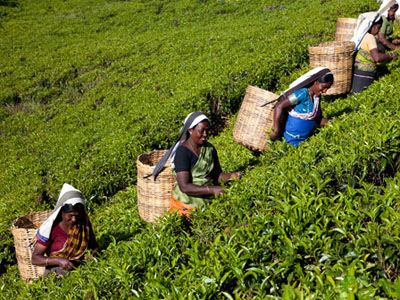Planters’ Association says sustainability of tea industry in the hands of workers
A 2kg increase in daily plucking average of tea can provide win-win solution
A marginal increase of at least 2kg in the daily plucking average of each tea plucker can significantly boost Sri Lanka’s entire plantation industry and benefit all stakeholders by bringing down the skyrocketing unit cost of production of tea by nearly seven per cent, the Planters’ Association of Ceylon reveals, reiterating that the sustainability of the sector and the livelihoods of the plantation communities are in the hands of the workers and the unions.
Noting that at approximately Rs. 460 per kilogramme, Sri Lanka’s unit production cost of tea is the highest in the world and the country’s unit labour cost in itself is higher than the total unit cost of production of some of its competitors, the Planters’ Association estimates that a 2kg increase in the daily plucking average of tea of each worker can bring down unit cost of production by Rs. 30 or 6.5%. Such a development can boost the Regional Plantation Companies’ (RPCs) total revenue and mitigate the unsustainably high costs they are grappling with at present.

The RPC estates are compelled to offer 300 days of work per annum, irrespective of the daily output levels of the workers or the reduced cropping conditions in the fields as a result of erratic and changing weather conditions that are not uniform throughout the year. During the lean cropping months, the RPC estates have paid full daily wages to the workers although their averages are about 50% of the expected averages and during high cropping periods, workers are paid extra for any output harvested above the norm, the Planters’ Association notes.
The RPCs have unfailingly ploughed back earnings to the plantation sector, making substantial capital investments since privatization. They are investing significantly in further improving free healthcare, accommodation and other facilities provided to workers in addition to wages. “Productivity improvements that increase the viability and sustainability of the estates, which provide livelihoods and employment for the workers would thus be a win-win situation, enabling workers themselves to reap substantial dividends,” the Association emphasizes. Productivity improvements also serve a dire need, especially following the unprecedented fall in the global rubber prices to record lows below even the cost of production, resulting in tea – which too is facing turmoil in major export markets – being the only major source of income for most plantation companies, the Association cautions.
Since labour costs excluding salaries of managers, administrative staff on the estates etc. account for between 67% to 70% of the total cost of production of local plantation companies and as the country has the lowest output per plucker in comparison with its competitors India and Kenya, an incremental increase is highly achievable even after making allowance for lower land productivity, the Planters’ Association reasons. This is especially true in the case of male pluckers (who represent around 20% of the workforce engaged in harvesting) whose productivity is woefully low – at the maximum 60% to 70% of that of their female counterparts. This is in stark contrast to competitor countries like Kenya in which the plucking average of male workers is substantially greater than that of females, the Association points out.
According to statistics, (The Long-term Profitability & Productivity of SL’s RPCs by Dr. Ramani Gunatilaka) at present the daily plucking average of around 18kg of a local worker is less than half of that of a Kenyan worker (48kg) and is only two thirds of that of a South Indian worker (27kg). Largely due to the significantly higher unit labour cost and lower productivity, at approximately USD 4, the cost of production of a single kilogramme of tea is highest globally in Sri Lanka.
While Ceylon Tea commands a premium at USD 3.6 a kilogramme (USD 1.4 more than tea from Kenya and USD 1.5 more than tea from India) (according to Tea Market Report – June 2014) this is far more than negated by the substantially higher cost of labour and lower productivity resulting in a loss of approximately USD 0.4 per kilogramme. At approximately USD 5.3, the daily wage of a Sri Lankan plucker is almost double that of a Kenyan plucker (USD 2.6) and more than double that of a plucker from South India (USD 2.1). When compared with a counterpart from Kenya and South India respectively, the wage premium commanded by a Sri Lankan worker stands at approximately USD 2.7 and USD 3.2.
In addition to higher wages, local Regional Plantation Companies also incur substantial amounts in providing far more comprehensive accommodation, healthcare facilities and traditional and established benefits and amenities to their workers and families than those enjoyed by workers in competitor nations.
 “We readily acknowledge that it is unrealistic to expect the plucking average of a Sri Lankan worker to equal that of a Kenyan worker because of many inherent factors prevailing in the local tea sector and neither is that the request of the Regional Plantation Companies,” Planters’ Association Chairman, Roshan Rajadurai explained. “What we request for is an extremely reasonable incremental increase of at least 2kg in the daily plucking average per worker, which is highly feasible but would nevertheless go a long way in assisting the companies to break even.” “We readily acknowledge that it is unrealistic to expect the plucking average of a Sri Lankan worker to equal that of a Kenyan worker because of many inherent factors prevailing in the local tea sector and neither is that the request of the Regional Plantation Companies,” Planters’ Association Chairman, Roshan Rajadurai explained. “What we request for is an extremely reasonable incremental increase of at least 2kg in the daily plucking average per worker, which is highly feasible but would nevertheless go a long way in assisting the companies to break even.”
“There is ample evidence to prove that workers can actually pluck far more than 2kg extra, if they really set their minds to do it,” he pointed out. “They must realise that any improvement in productivity will cushion the impact of the very high cost of production in Sri Lanka and eventually will help to sustain the tea industry, through cost reduction and improved competitiveness in the global marketplace. If the industry collapses, it will be the workers who will face the brunt of such a disaster. Already, we have heard reports that some rubber small holders have stopped tapping rubber because it is unviable and they have alternate sources of employment. However this will not be the case for the approximately one million plantation community resident in the plantations, who are enjoying all the benefits provided since they’re employed in the estates.”
“Especially following the substantial decline in rubber prices, the workers and the unions are at a crucial juncture and can decide to cooperate with the plantation companies to benefit mutually and put the industry on a sounder footing or can decide not to cooperate, which will at some point inevitably lead to the local plantation sector becoming financially unviable,” he said further.
The request by the Planters’ Association comes in the backdrop of volatility in the prime markets for Ceylon Tea – the Middle East, Russia and Ukraine – contributing 70% of total value and a massive crash in rubber prices to one of the lowest levels in recent history.
Released in October 2014
|